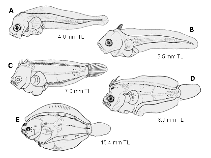| FishBase |
Larvae Information Summary for
Paralichthys dentatus

| Main Ref: | Scotton, L.N., R.E. Smith, N.S. Smith, K.S. Price and D.P. de Sylva 1973 | |||
Yolk-sac larvae
| max | min | mod | Ref. | |
| Length at birth (mm) | 3.1 | 39017 | ||
| Preanal L. % TL |
| Place of development | ||||
| Larval area | Delaware Bay (USA) | |||
| Yolk-sac | Ref: | |||
| Yolk | Oil globules | |||
| Rows on tail | no rows | |||
| Other melanophores on tail | tail partly covered with melanophores | |||
| Melanophores on head + trunk | melanophores on head + trunk | |||
| Vent is located about halfway between snout and tip of tail. At about 3 mm, pigment is scattered and faint, caudal finfold unpigmented except for melanophores at its base. At slightly large size, pigment spots more numerous and larger. | ||||
Post larvae
| Striking feature | none | |||
| Striking shape lateral | normal (not striking) | dorsal | ||
| Striking feature | none | |||
| Shape of gut | ||||
| Gas bladder early | late | |||
| Spinal armature early | no spines | late | no spines | |
| Pigmentation early | ||||
| Rows on tail | dorsal + ventral row | |||
| Other melanophores on tail | no other melanophores | |||
| Melanophores on head + trunk | melanophores on trunk | |||
| Rows on tail | dorsal + ventral + lateral row | |||
| Other melanophores on tail | no other melanophores | |||
| Melanophores on head + trunk | melanophores on head + trunk | |||
| Peritoneum | with row of melanophores | |||
| Pectorals | normal | |||
| Pelvics | normal (i.e. small or absent) | |||
| At 3.4-8.0 mm, pigment spots are present on the dorsal and ventral finfolds and along the dorsal and ventral edge of the trunk and tail. At 8.0-9.5 mm, There is a row of 7 to 9 melanophores along the lateral line and small spots along the ventral edge of the head and gut. At about 9.5 mm SL, right eye begins to move to the left side. At 12.0 mm SL, right eye can be seen over the dorsal edge of the skull. At 12.1-14.0 mm, the full complement of fin rays are present; from this size on, the dorsal fin ray number serves to separate P. dentatus from P. oblongus. Postlarval pigmentation along the dorsal and anal fins does not appear to be a consistent characteristic: the 'well-defined' band of black pigment along the border of the anterior 4/5 of the dorsal and anterior 2/3 of the anal fin in specimens 9-15 mm SL was not present in postlarvae from Cape Sable to Block Island, and was not evident presumably until the dorsal and anal fin rays were formed, i.e., at about 12 mm, in another study. | ||||
| L 1st feeding | Ref. | Months of presence of larvae | ||||
| max | 8 | 39467 | Jan | Feb | Mar | Apr |
| min | 3.4 | 39467 | May | Jun | Jul | Aug |
| mod | Sep | Oct | Nov | Dec | ||
| Water parameters Metric characters |
| Back to Search |